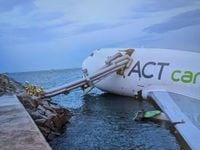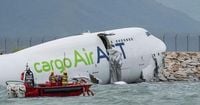In the early hours of October 20, 2025, tragedy struck at Hong Kong International Airport, one of the world’s busiest aviation hubs, as a cargo plane skidded off the north runway and collided with a security patrol vehicle, sending both the aircraft and the vehicle into the sea. The devastating incident claimed the lives of two airport workers and left the aviation community reeling, even as authorities raced to investigate the causes behind the accident.
The Boeing 747 freighter, identified as Emirates Flight EK9788, was operated by Turkey-based ACT Airlines under a wet lease agreement with Emirates SkyCargo. The flight had departed from Al Maktoum International Airport in Dubai and touched down in Hong Kong at approximately 3:50 a.m. local time. According to the Airport Authority, the weather and runway conditions were suitable for landing, and all systems appeared normal as the aircraft approached the runway. Yet, what followed was anything but routine.
Steven Yiu, executive director of airport operations at the Airport Authority Hong Kong, explained at a press conference that the plane had taxied about halfway down the north runway before unexpectedly veering off to the left. In a harrowing sequence, the aircraft crashed through the airport’s perimeter fence and struck a security patrol car positioned on the other side, pushing both the plane and the vehicle into the waters bordering the airport. Yiu emphasized, “The patrol car absolutely did not rush onto the runway. It was the plane that went off the runway and crashed into the patrol car outside the fence.”
The two security workers in the vehicle, a 41-year-old driver with 12 years of service and a 30-year-old security guard who had worked at the airport for seven years, were tragically killed. One was pronounced dead at the scene, while the other succumbed to injuries after being rushed to hospital. “We are deeply saddened and extend our deepest condolence,” said Yiu. “We will provide the family with all necessary support and assistance.”
Rescue efforts were swift and extensive. Over 200 firefighters and first aid officers, supported by 45 vehicles, ships, and a helicopter, responded to the scene. Divers located the sunken patrol car about five meters from shore and recovered the two victims. Meanwhile, the four crew members aboard the aircraft managed to break open the door and were rescued from the partially submerged wreckage. Miraculously, they escaped without serious injury and were sent to local hospitals for medical evaluation.
Images from the scene painted a sobering picture: the aircraft’s front half and cockpit remained visible above the water, while the tail section had broken off. The emergency slide was deployed, and damage was evident below the cockpit. The sight of the giant freighter, once a passenger plane before being converted for cargo, lying in the sea just off the airport’s edge, underscored the severity and rarity of such an event.
Hong Kong International Airport, built on reclaimed land at the mouth of the Pearl River and surrounded by water on several sides, is no stranger to logistical challenges. The north runway, where the accident occurred, lies only a few hundred meters from the sea wall. Despite the dramatic crash, airport authorities moved quickly to contain the operational impact: the north runway was closed for investigation, but the airport’s two other runways remained open, and passenger flight operations continued as scheduled. However, at least 12 cargo flights were canceled as a direct result of the accident.
Officials from the Civil Aviation Department and the Air Accident Investigation Authority were on site soon after the crash, launching a comprehensive inquiry. Man Ka-chai, the chief investigator, confirmed that the aircraft had been cleared to land and did not issue any distress signals or requests for assistance prior to the accident. “The control tower did not receive any requests for assistance,” he said, adding that the investigation would examine multiple angles—including aircraft maintenance, flight operations, and weather conditions. Authorities were also working to retrieve the aircraft’s black boxes—the flight data recorder and cockpit voice recorder—from the sea, a process that could shape the speed and depth of the investigation.
While the exact cause of the crash remains undetermined, early statements from both the Airport Authority and aviation experts suggest that the incident was sudden and unexpected. Tony Stanton, an aviation safety consultant and pilot, told Al Jazeera, “This was something that happened obviously very quickly and unexpectedly.” He noted that investigators would rely heavily on flight data and crew interviews to piece together the sequence of events.
Emirates, in a statement, expressed condolences to the families and colleagues of the two airport employees who lost their lives, reaffirming its commitment to cooperate fully with the investigation. The airline clarified that the Boeing 747 freighter was wet-leased and operated by ACT Airlines, with no cargo on board at the time of the accident. ACT Airlines, which has experienced a fatal crash before—in 2017, a Boeing 747 operated by the company crashed in Kyrgyzstan, killing all four crew and 35 people on the ground—also pledged to support the ongoing inquiry.
The Transport and Logistics Bureau of Hong Kong echoed the sense of loss felt across the city’s aviation sector, stating, “The TLB is saddened by the loss of two ground staff members in the accident and extends its deepest condolences to their families,” and emphasizing that “flight safety is of utmost importance.”
Monday’s crash stands as the deadliest airport accident in Hong Kong since 1999, when a China Airlines flight crashed on landing, claiming three lives. For many in the city and the wider aviation community, the incident is a stark reminder of the risks that persist even amid the most stringent safety protocols and advanced technology. The fact that the aircraft was 32 years old, previously serving as a passenger jet before being converted to a freighter, has also drawn attention as investigators look into possible technical or maintenance issues.
As the investigation continues, families of the victims, airport staff, and the broader community await answers. The search for the black boxes and further analysis of the aircraft’s systems may provide crucial insights into what went wrong on that fateful morning. Until then, the loss of two dedicated airport workers serves as a somber testament to the unpredictable hazards faced by those who keep the world’s airways running safely and efficiently.





